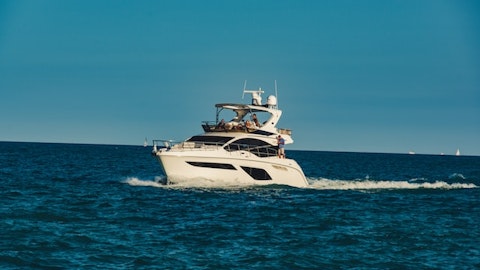MasterCraft Boat Holdings, Inc. (NASDAQ:MCFT) Q2 2024 Earnings Call Transcript February 7, 2024
MasterCraft Boat Holdings, Inc. isn’t one of the 30 most popular stocks among hedge funds at the end of the third quarter (see the details here).
Operator: Ladies and gentlemen, thank you for standing by. Welcome to Q2 2024 MasterCraft Boat Holdings, Incorporated Earnings Conference Call. [Operator Instructions]. Please be advised that today’s conference is being recorded. I would like now to turn the conference over to Bobby Potter, Vice President of Strategy and Investor Relations. Please go ahead.
Bobby Potter: Thank you, operator, and welcome, everyone. Thank you for joining us today as we discuss MasterCraft’s second quarter performance for fiscal 2024. As a reminder, today’s call is being webcast live and will also be archived on our website for listening. With me on this morning’s call are Fred Brightbill, Chief Executive Officer and Chairman; and Tim Oxley, Chief Financial Officer. Fred will begin with a review of our operational highlights from the second quarter. Tim will then discuss our financial performance for the quarter. Then Fred will provide some closing remarks before we open the call for Q&A. Before we begin, we would like to remind participants that the information contained in this call is current only as of today, February 7, 2024.
The company assumes no obligation to update any statements, including forward-looking statements. Statements that are not historical facts are forward-looking statements, and subject to the Safe Harbor disclaimer in today’s press release. Additionally, on this conference call, we will discuss non-GAAP measures that include or exclude special or items not indicative of our ongoing operations. For each non-GAAP measure, we will provide the most directly comparable GAAP measure in today’s press release. This includes a reconciliation of these non-GAAP measures to our GAAP results. There is also a slide deck summarizing our financial results in the Investors Section of our website. As a reminder, unless otherwise noted, the following commentary is made on a continuing operations basis.
With that I will turn the call over to Fred.
Fred Brightbill: Thank you, Bobby, and good morning, everyone. Our business performed well during the second quarter as we delivered better-than-expected results despite continuing macroeconomic uncertainty in a highly competitive retail environment. Near term, we remain focused on rebalancing dealer inventories with anticipated demand to ensure the health of our dealer network. Despite near-term challenges, our portfolio of consumer-centric brands, a highly variable cost structure and our strong balance sheet provide us with the confidence to continue to invest in long-term growth initiatives. In addition to maintaining a resilient balance sheet and investing for the future, our disciplined approach to capital allocation allows us the flexibility to return cash to shareholders through our share repurchase program, regarding the economic outlook are mixed and uncertain, which is limiting retail demand visibility.
Recently, we observed some relatively positive indications that favor cautious optimism, including the expectation for lower interest rates, improving consumer sentiment and unexpectedly strong GDP growth. We continue to monitor retail results and assess the overall business and economic environment. We are confident that our flexible operating model will allow us to mitigate near-term risk and capitalize on the upside when we return to growth. Although inventories modestly increased during the quarter, seasonal increase was less than typical in pre-COVID periods. We prioritized pipeline rebalancing and dealer health as we enter fiscal 2024. Other industry participants are now signaling softening demand while pairing their expectations significantly in some cases.
We believe the decisive action we took to right-size our production plan from the start of fiscal 2024 has allowed us to transition to a more historical pattern of inventory build and destock. Dealer inventory units normally increased to a relative peak during our fiscal third quarter before declining throughout the summer selling season. While dealer inventories remain higher than we consider optimum, we expect levels to improve by the end of the fiscal year. As other industry participants begin to react to lower demand, the retail environment has become increasingly competitive. Dealers continue to focus on destocking to manage inventory levels and reduce floorplan costs. The resulting increase in promotional activity is pressuring margins across the industry.
Results from early boat shows are mixed. although many of the way shows have exceeded expectations. We anticipate that retail activity will support our range of wholesale expectations. The environment is very competitive as inventory availability has improved providing consumers with more choices. The good news is that there are buyers. However, a general lack of urgency is contributing to increased promotional activity. Our dealer inventory levels and production plans position our dealers to capitalize on the remaining boat shows in the upcoming summer selling season. We expect to have a clear picture of retail demand as we progress through our third and fourth quarters. Despite the cyclical headwinds facing the industry, we are well-positioned to pursue our capital allocation priorities, including investment in long-term growth.
We are prudently investing in targeted initiatives that will take advantage of the industry’s positive underlying secular trends. I will briefly discuss one such initiative as I review the operational results of our brands. With our financial position secured and our current strategic growth initiatives fully funded, we expect to continue to allocate most of our free cash flow for the year to our EPS accretive share repurchase program. Our balance sheet and capital allocation framework provides us with flexibility to adjust our stance from cautious to optimistic, depending on our view of the cycle. Given the currently suppressed marine environment, and near-term uncertainty, we will remain opportunistic in our approach to grow through M&A. Let me now briefly review some of the latest developments across our brands.
Our MasterCraft brand, net sales were $73 million for the quarter, down 33% from the record prior year period. The decrease in net sales was in line with our expectations given the planned production decrease to rebalance dealer inventories in response to lower retail demand. MasterCraft team is actively supporting our dealer partners at boat shows occurring across the country and globally. MasterCraft performed particularly well at the Atlanta, Seattle and Salt Lake City shows. At Crest, net sales were $17 million for the quarter, down 54% from the prior year period as expected due to a pullback in production to align with retail demand. Early boat show results have been mixed, but encouraging as consumer interest in pontoons has been better than anticipated.

However, consumers lack a sense of urgency and the sales cycle is taking longer than expected in the last few years. Press performed particularly well as Minneapolis show, the largest pontoon market in the U.S., along with the Chicago, Atlanta and Detroit shows. On the strategic front, we will be launching a new pontoon brand for model year 2025 that will be built in our Crest facility. This new brand was conceived through our consumer-centric approach to strategic planning and we’ll be focused on targeting affluent customer with an elevated on-water and in water experience. We will be launching the brand consumers in the spring and look forward to sharing more information on this exciting growth initiative with investors on our next earnings call.
At Aviara, net sales were $10 million for the quarter down 30% compared to the prior year period. During the quarter, Aviara was focused on the ramp-up of the all-new AV28, an impressive product platform consisting of 4 distinct model variants. We expect the AV28 production to continue to ramp up for the remainder of the year. Aviara has also expanded its distribution network by adding 8 new domestic and international points of distribution fiscal year-to-date. Social results for Aviara have been mixed, but we are encouraged by the results of some shows, including New York and Seattle. We recently hired Michael Connell, a 30-year industry veteran to be President of Aviara. Mike’s senior leadership roles at several bunk manufacturers gives him a wealth of experience and knowledge that he will leverage to improve Aviara’s operational performance and execute its growth strategy.
I will now turn the call over to Tim, who will provide a more detailed discussion of our financial results. Tim?
Tim Oxley: Thanks, Fred. Focusing on the top line, net sales for the quarter were $99.5 million, a decrease of $59.7 million or 38% from the record prior year period. This decrease was primarily due to lower unit sales volume and an increase in dealer incentives partially offset by higher prices and favorable mix. Dealer incentives include higher floor plan financing costs as a result of increased dealer inventories and interest rates, and other incentives as the retail environment remains very competitive. For the fourth quarter, our gross margin was 18.8%, a decrease of 520 basis points when compared to the prior year period. Lower margins were the result of lower cost absorption due to planned decreased production volume, higher dealer incentives and higher costs related to material labor and overhead inflation partially offset by higher prices.
Operating expenses were relatively consistent for the second quarter of fiscal 2024 compared to the prior year period. In pursuit of growth initiatives, we continue to invest in product development and marketing. Turning to the bottom line, adjusted net income for the year decreased to $6.3 million or $0.37 per diluted share, computed using estimated annual effective tax rate of 22%. This compares to adjusted net income of $21.3 million or $1.20 for the prior year period, computed using that tax rate of 23%. Adjusted EBITDA decreased to $9.8 million for the quarter compared to $29.8 million in the prior year period. Adjusted EBITDA margin was 9.8%, down 890 basis points from 18.7% in the prior year period. Our balance sheet remains incredibly strong as we ended the quarter with nearly $209 million of total liquidity, including nearly $109 million of cash and short-term investments and $100 million of availability under our revolving credit facility.
We ended the quarter with no debt as cash and short-term investments exceed our outstanding debt balance. Year-to-date, we have generated more than $19 million of cash flow from operations. Our balance sheet positions us exceptionally well and provides us with ample financial flexibility to ensure sound operations through the business cycle and the ability to fund strategic growth initiatives. During the quarter, we spent approximately $4.4 million to repurchase more than 214,000 shares of our common stock. Since initiating our share repurchase program in June of 2021, we spent more than $58 million to repurchase over 2.3 million shares. These cumulative repurchases provided a 13% benefit for our fiscal second quarter adjusted net income per share.
We expect to continue to return cash to shareholders while prioritizing financial flexibility and high return investments in the business that generate growth and long-term shareholder value. Looking forward, we are narrowing our guidance range for the full year. Consolidated net sales is now expected to be between $400 million and $412 million with adjusted EBITDA between $42 million and $47 million and adjusted earnings per share of $1.53 and $1.78. We also now expect cash flow expenditures to be approximately $20 million for the full year. For the third quarter of fiscal 2024, consolidated net sales is expected to be approximately $92 million with adjusted EBITDA of approximately $7 million and adjusted earnings per share were approximately $0.23.
Although our guidance reflects a significant decline in earnings from fiscal 2023, we expect to generate positive free cash flow, which is a testament to our flexible, highly variable cost structure and proactive cost control efforts. I’ll now turn the call back to Fred for his closing remarks.
Fred Brightbill: Thanks, Tim. As we continued our focus on rebalancing dealer inventories, our business performed well during the second quarter by delivering better-than-expected results despite the continuing economic uncertainty in a highly competitive retail environment. We continue to exercise a disciplined approach to capital allocation. Over the past 2 years, we’ve returned more than $58 million of excess cash to our shareholders through our share repurchase program. Our strong balance sheet provides us with financial flexibility and affords us the opportunity to pursue our strategic growth initiatives. The upcoming launch of our exciting new pontoon brand is an example of why we are confident in our ability to deliver long-term growth for our shareholders.
As we move beyond inventory rebalancing, we are determined to leverage our strong and growing portfolio of brands, deliver on our commitments, pursue long-term growth opportunities and generate exceptional shareholder returns. Operator, we may now open the line for questions.
See also 10 Stocks Receiving a Massive Vote of Approval From Wall Street Analysts and 10 Blue-Chip Stocks At 52-Week Lows.
Q&A Session
Follow Mastercraft Boat Holdings Inc. (NASDAQ:MCFT)
Follow Mastercraft Boat Holdings Inc. (NASDAQ:MCFT)
Operator: Thank you. [Operator Instructions] The first question comes from Joe Altobello with Raymond James. Your line is now open.
Joe Altobello: So first question I wanted to ask about the guidance. It implies a sequential decline in sales and EBITDA from Q2 to Q3, which is unusual. Is that all due to heightened promotional activity or are there other dynamics going on in the business?
Tim Oxley: There are other dynamics, Joe. For instance, we were shut down for a full week of production due to snow here in Tennessee, ice storm effective production at Crest as well. The other thing we’re doing is making sure we allow our dealers some breathing room to clear the decks for additional inventory in Q4.
Joe Altobello: Okay. That’s helpful, Tim. And maybe in terms of units this year, I think the expectation at least 3 months ago was units would be down over 40%. Is that still the case, and if so, does that get field inventories to where you need them to be by fiscal year-end.
Tim Oxley: That’s what we are expecting, Joe.
Joe Altobello: Okay. And so it sounds like you guys will exit the fiscal year clean, if you will from an inventory perspective.
Tim Oxley: Absolutely. And keep in mind the fourth quarter our retail will determine exactly where we land.
Operator: The next question comes from Craig Kennison with Baird. Your line is now open.
Craig Kennison: I wanted to start with just a question, Fred, on your perspective on the health of your dealer network. We know they’re under a lot of strain with skinny margins and excess floor plan costs, but how would you characterize the health of your dealer network?
Fred Brightbill: I would characterize it overall as very good. And that’s not to say that there isn’t an occasional issue here or there, but it’s been very sporadic and isolated, but certainly, as you’ve indicated, dealers are, in general, heavily inventoried, incurring additional costs and they’re selling at very tight margins, which is not a long-term sustainable situation. We don’t expect them to be in that situation long term. We expect to get through this and be able to return to more normal conditions.
Tim Oxley: Craig, I would add, we monitor the dealers health. We’ve been watching it very closely. We have a monthly meeting with the floor plan companies to make sure there are no early warning signs of duress and we’ll continue that through the season.
Craig Kennison: Is there a way to frame the number of units by which you exceed maybe target inventory levels in the channel?
Fred Brightbill: Well, the way we think about it, Craig, is again where we’re trying to end up at the end of the year. And this year, we still expect to pull out somewhere between 600 and 800 units.
Tim Oxley: Split fairly between press brands.
Craig Kennison: That’s really helpful. And then I guess 1 more question on the decision to add a Pontoon brand within the Crest facility. Just if you would, talk about any sort of capital requirements that entails? And what’s the broader vision for having 2 brands instead of just one.
Fred Brightbill: First of all, minimal capital expense, don’t have the same 200 requirements on the pontoon business, as you would in the fiber glass in terms of molds, facility expansion, directly related to that facility expansion was recently completed within the last year that provides the capability, be able to produce this product. So there was some investment made, but it has been made historically. And as we look forward, I don’t expect any significant capital allocation to the new brand. With regard to the positioning because of its premium, almost ultra-premium positioning, we felt it was appropriate to have the brand and be able to target it to those consumers specifically. It will touch on the upper end of the offering in terms of price points of the Crest brand. So there’s some minor overlap but in general it’s going to be positioned differently than the Crest brand.
Operator: The next question comes from Eric Wold with B. Riley Securities. Your line is open.
Eric Wold: Two questions. I guess, one, just a follow-up. I can’t remember if Frederic, when you talked about the dealers seeing kind of extraordinary low margins right now on boat sales. If you take floor plan costs out of the equation to try to kind of get to an apples-to-apples basis with pre-pandemic levels to take interest rates out, are the margins are seeing lower than pre-pandemic because of higher promotions or the extra pressure purely from the floor plan cost?
Fred Brightbill: And I believe it’s in addition to the floor plan costs, Eric. In such a competitive market now, that price competition has driven down their margins in addition to the floor plan costs.
Tim Oxley: And typically, the dealers book the floor plan cost in their G&A, so it doesn’t affect their margin, so it’s very competitive out there. And their margin on current product is significantly different than the margin on noncurrent. And that’s always been the case, but they have more noncurrent than is typical. So typically for dealers, you’ll see the noncurrent margins coming down and the current margins remaining pretty steady. And I think that’s the case, but there are more noncurrents now than they’ve had in the past.
Eric Wold: And do you expect the competitive environment to remain in place even after channel inventories get to more healthier levels? Is that kind of a different environment right now or is it really because of the higher inventories out there?




